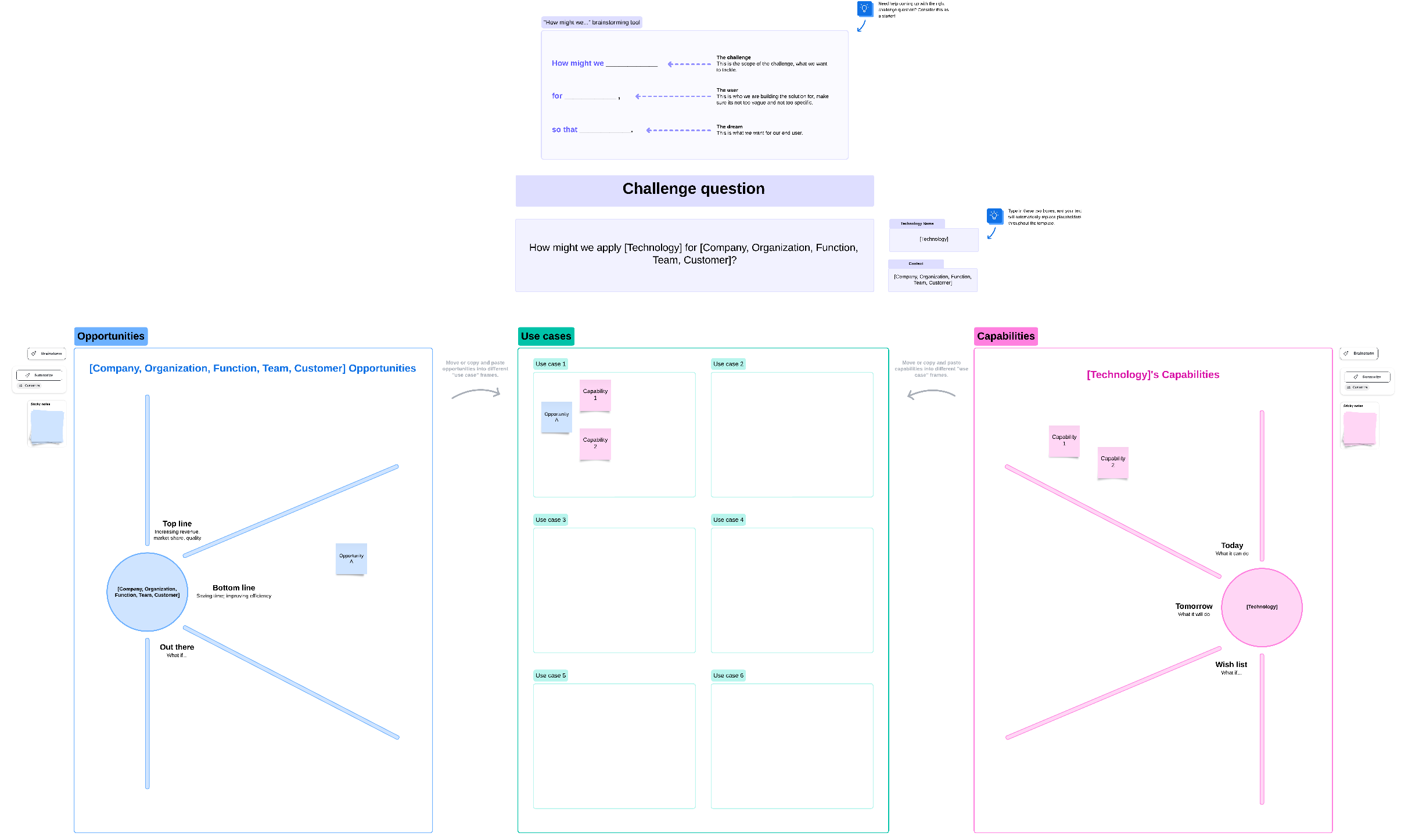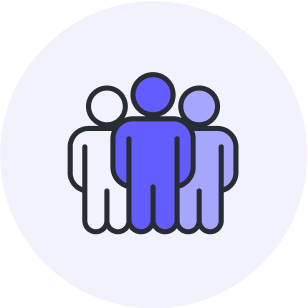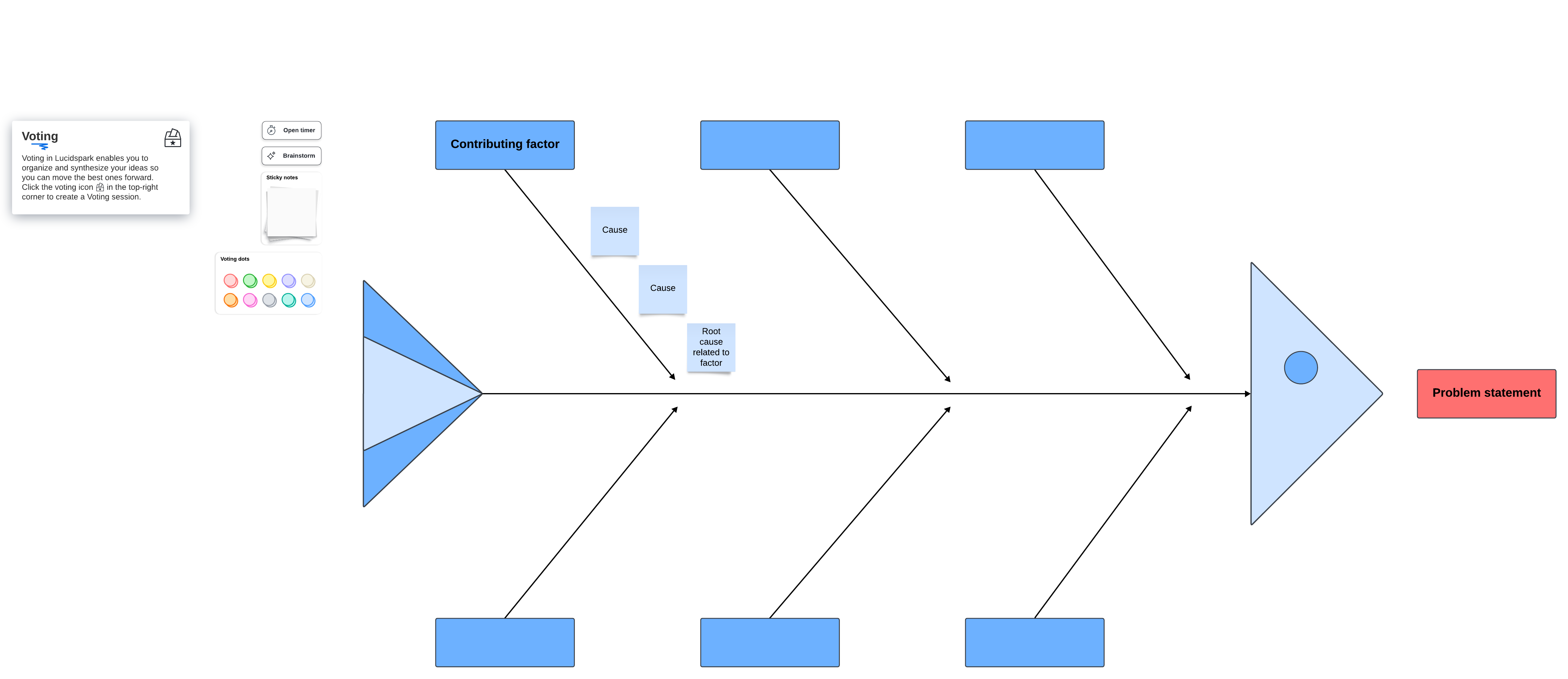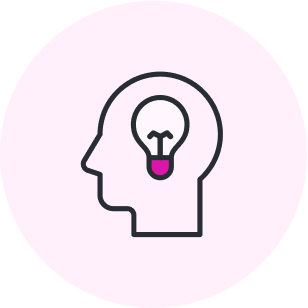
The top AI adoption challenges (+ solutions) in the workplace
Reading time: about 8 min
Topics:
Despite all the buzz we’ve heard around AI lately, many workers are struggling to embrace this new technology. Lucid’s recent survey shows that only 42% of entry-level workers are using AI-powered collaboration tools.
What’s preventing more people from adopting AI into their workflow?
Undoubtedly, there are significant technical, security, and privacy challenges to consider when adopting AI. But some of the most complex challenges stem not from the technology itself but rather the implications it has on the people using it. AI adoption, after all, comes with a great deal of uncertainty and change.
In this blog post, we’ll examine three of the greatest AI adoption challenges affecting workers today and provide pragmatic approaches to overcoming them.
Challenge #1: AI initiatives don’t align with broader business goals
Whether due to internal pressure or the allure of AI's productivity gains, organizations have been eager to jump on the AI bandwagon. But those who did so without clear goals or strategies for actually using AI are likely struggling to see the full benefits AI offers.
Experimentation, of course, is incredibly valuable for learning, but before you jump straight into this step, you need to start with a well-developed plan. Put another way, your AI goals must align with your overall business strategy. If you’re not intentional about where and how you’re applying (or experimenting with) AI, it can end up having the opposite effect on employee morale and productivity from what it’s intended to have.
Here’s the real kicker: Without a plan, you’ll have no way to measure return on investment (ROI). How will you know if AI is just an added expense for the business or if it’s accelerating earnings, making teams more efficient, or reducing risk?
Solution: Create a clear value case around AI
If you’re struggling to see the benefits of AI, take some time to map out your business’s specific value case for the technology—in other words, why are you implementing AI in the first place?
To identify areas of the business where AI would be beneficial, you’ll want to consider two main factors: your current business opportunities and AI’s current and future capabilities.
“I often refer to this process as working from ‘opportunities out’ and ‘technology in,’” says Patrick Saul, solutions consultant on Lucid’s professional services team. “You can start with the business opportunity and work your way out to how a new technology would support it. Or, start with the technology and its capabilities and allow that to guide you towards the right opportunities to focus on today.”

Typically, these opportunities will take the form of either ways to improve the bottom line—such as cutting costs or improving efficiency—or market opportunities to capitalize on, such as a new avenue for revenue and growth.
For example, a trading firm may consider this market opportunity: How much additional revenue could be made if we could clone our best trader? Or, a manufacturer may consider this opportunity for improvement: How much could we reduce our routine inspection time by incorporating AI and robotics into the process?
By creating clear goals around your AI adoption, you’ll be better able to measure outcomes and progress toward those goals. “Like any learning program of this type, there should be expected, measurable outcomes, even if those are measures of the number of experiments or rate of learning,” says Dan Lawyer, CPO at Lucid. “At some point, these experiments will turn into measurable and reproducible use cases that can be shared as best practices that truly accelerate the business.”

Measuring innovation
Learn how to set goals and metrics for measuring innovation and experimentation around AI.
Check it outChallenge #2: AI represents change and uncertainty for teams
33% of workers consider resistance to change to be a top challenge when implementing AI, Lucid’s survey shows.
AI disrupts the status quo, and getting used to a new way of working isn’t easy. 26% of survey respondents indicated that they’re hesitant about AI simply because they prefer traditional methods and tools.
Perhaps even more challenging is that not all resistance comes from adjusting to new tools—many people also fear what AI means for their jobs. One out of three workers are worried that their jobs could be replaced by AI.
What can organizations do to help their people feel comfortable and confident when using AI?
Solution: Prioritize your change management strategy
Your change management strategy should be a critical part of your enterprise AI adoption strategy, not an afterthought.
There are many change management frameworks you can follow, but, regardless of which you choose, we recommend you keep the following tips in mind:
Develop—and communicate—your case for change. If you’ve done the work of mapping business opportunities to AI capabilities, you’ll already have solid reasoning for the change. Now the trick is communicating those benefits to the rest of your workforce. Get specific on how AI will save time, improve work-life balance, or solve key problems for the people at your organization.
Be empathetic in your communication and carefully address peoples’ fears. Remind your workforce that AI is not here to replace them; it’s here to augment their work—and, more importantly, help them.
“One way you can minimize fear is by clearly differentiating jobs from tasks. AI is a great tool for performing certain, often monotonous, tasks in a workflow—like summarizing content or creating outlines—not for replacing entire jobs.”
—Patrick Saul, solutions consultant at Lucid
Embrace input across the organization. Lucid’s survey revealed that executives are embracing AI far more readily than the rest of the workforce, with 83% of executives using AI-powered collaboration tools compared to only 42% of entry-level workers. This gap shows just how important it is to talk to teams across the business and gather their feedback on where and how AI could be implemented.
“One strategy is to engage individuals in pilot programs and collaborative design early in the process,” says Saul. “Encourage them to define and help address their own concerns with AI. Then, reframe their concerns in ways that are more intuitive and human-centric.” For example, if they’re concerned that AI will provide incorrect information, ask them to consider how they’d validate the information if it came from a person, rather than AI. This reasoning by analogy is a common tool used in the human-centric design process, and it will allow you to ease concerns while creating buy-in for the change.
Share success stories across the organization. Seeing innovative ways others are using AI in the organization can inspire individuals to embrace and experiment with AI themselves.
“Create internal forums where users can share positive and negative examples of how they have used AI,” explains Lawyer. “Including some executive leaders in these forums will help set the tone and expectation for others in the org.”

Change management guide
Get the step-by-step guide to leading effective change at your organization.
Get the guideChallenge #3: Teams don’t know how to use AI
Some people are fearful of AI, some are hesitant to change their workflow, and others, well, they simply don’t know how to use AI. In fact, 41% of entry-level workers in our survey feel hardly or not at all knowledgeable about AI-powered features (compared to just 10% of executives).
It can be challenging to learn a new tool that’s constantly changing. Not to mention, the output of generative AI isn’t always trustworthy. However, there are steps organizations can take to help their workforce learn and grow comfortable with using AI.
Solution: Encourage experimentation and provide training when possible
Those unfamiliar with AI may assume using it requires advanced technical skills. However, most of the skills needed to use AI successfully are related to problem-solving and critical thinking.
“AI continuously learns and becomes more effective and easier to use over time,” explains Saul. “The more difficult challenge becomes creatively figuring out what problems to apply AI to.”
To help people identify opportunities for using AI, provide resources or training on frameworks and techniques such as root cause analysis (try the 5 whys and fishbone templates to get started) and divergent thinking. You may even encourage teams to practice mapping out processes or workflows as this type of visualization often helps people better understand areas of inefficiency where AI could help.

It may also be beneficial to train employees on writing effective AI prompts—that is, communicating with AI to get the desired output. The most valuable factor here, though, will be experimentation.
“Create space for safe experimentation,” says Lawyer. “Some members of your team need the ability to have creative play with the AI in their work so that they can discover the highest value points and then propagate those out to the rest of the team.”

Challenges solved by AI
Need some inspiration on ways to use AI? Read how AI solves these common challenges in the workplace.
Get the guideLastly, it’s important to provide clear and simple guidelines on using AI securely and ethically. For example, you may outline a security practice for AI, such as: “Do not put customer data into AI systems that are not corporate-approved.” Or, you may want to provide training or resources on how to verify information from a generative AI system and detect hallucinations.
By outlining clear dos and don’ts for using AI, you’ll help your organization feel more comfortable experimenting with the new technology.
Simplify AI adoption with Lucid
Lucid aims to encourage and streamline AI adoption by incorporating AI naturally into the product and, therefore, into your workflow. Whether kick-starting a diagram, building on a brainstorm, or summarizing projects, it’s easy to use AI in Lucid to work smarter.
Plus, Lucid’s team of professional services consultants can help organizations use and apply Lucid’s AI to their unique use cases, manage change, and see value faster.

Get in touch
Learn more about Lucid professional services and contact our team to see how we can help.
Contact our teamAbout Lucid
Lucid Software is the leader in visual collaboration and work acceleration, helping teams see and build the future by turning ideas into reality. Its products include the Lucid Visual Collaboration Suite (Lucidchart and Lucidspark) and airfocus. The Lucid Visual Collaboration Suite, combined with powerful accelerators for business agility, cloud, and process transformation, empowers organizations to streamline work, foster alignment, and drive business transformation at scale. airfocus, an AI-powered product management and roadmapping platform, extends these capabilities by helping teams prioritize work, define product strategy, and align execution with business goals. The most used work acceleration platform by the Fortune 500, Lucid's solutions are trusted by more than 100 million users across enterprises worldwide, including Google, GE, and NBC Universal. Lucid partners with leaders such as Google, Atlassian, and Microsoft, and has received numerous awards for its products, growth, and workplace culture.
Related articles
Implementing AI across the entire product development workflow to enhance efficiency
Anthony Morelli, former Lucid senior director of product management, offers suggestions for implementing AI.
Maximizing AI’s potential in the workplace: New data highlights the barriers and benefits
Uncover data on the benefits, use cases, and gaps of AI in the workplace—including the perception gap among employees and executives.
How knowledge workers at every level can use and benefit from AI
Check out examples for how to use AI effectively–whether you’re an executive, a manager, or an individual contributor.
Closing the AI transformation gap: How to prepare your business for agentic AI
Uncover the greatest challenges in AI transformation and learn what steps you can take today to get your business ready for agentic AI.
